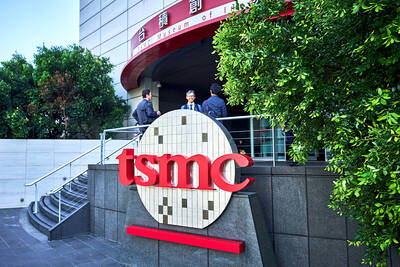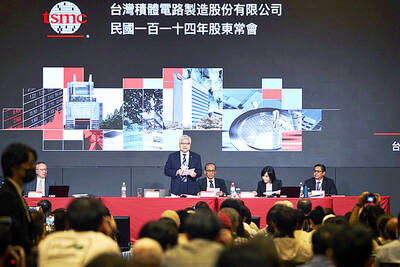The development of a domestic standard for optical information storage may boost the nation's position in the industry, but such a goal may be difficult to achieve, industry insiders said yesterday.
"Developing our own standard may give the nation's digital video disc (DVD) manufacturers, who are responsible for up to 80 percent of global DVD shipments, more negotiating power over royalties," said Gary Lai (賴晴風), an analyst at Insight Pacific Investment Research(
He made the remark after the Taiwan Advanced Optical Storage Research Alliance (
Disc makers such as CMC Corp (中環), recorder makers such as BenQ Corp (明基電通), chipset manufacturers such as VIA Technologies Inc (威盛電子) as well as software companies participated in the development scheme.
Lai said creating a new standard requires research and development work by hardware makers, such as those making DVD players and recorders.
The willingness of foreign companies, such as Royal Philips Electronics, which enjoy lucrative royalties, to give up their edge in this aspect, raises questions about the new standard, he said.
The first generation FVD, with a capacity of 5.4 to 6 gigabytes, uses a red laser to write in information onto the disc and uses Microsoft's compression technology -- Windows Media Video-9 -- to allow 135 minutes of high-definition content.
"Taiwan's DVD industry is the third-largest in the world after Japan and South Korea," said Huang Der-ray (黃得瑞), the alliance's chair as well as the deputy director-general of ITRI's Optoelectronics and System Laboratories.
The nation's DVD industry created some NT$280 billion worth of revenue last year, up from NT$210 billion in 2002, according to ITRI's figures.
The development of FVD is expected to lower domestic companies' royalty burden and create as much as NT$1 trillion worth of production in 2008 if the standard can be put into mass production, Huang said.
"We hope FVD will create a market while other advanced standards, like HD-DVD and Blu-Ray, are still not popular," he said. "The growing popularity of high-definition televisions may help as our standard outperforms current DVD specifications in this field."
The industry expects to start mass production under the FVD standard by the end of this year and sees an opportunity to prosper in the next two to three years, the industry veteran said.
Lite-On IT Corp (建興電子), the nation's largest original equipment manufacturer of DVD recorders, which also took part in the development project, said the success of the new standard depends on support and endorsements from global companies such as Dell Inc and Hewlett-Packard Corp.

With an approval rating of just two percent, Peruvian President Dina Boluarte might be the world’s most unpopular leader, according to pollsters. Protests greeted her rise to power 29 months ago, and have marked her entire term — joined by assorted scandals, investigations, controversies and a surge in gang violence. The 63-year-old is the target of a dozen probes, including for her alleged failure to declare gifts of luxury jewels and watches, a scandal inevitably dubbed “Rolexgate.” She is also under the microscope for a two-week undeclared absence for nose surgery — which she insists was medical, not cosmetic — and is

CAUTIOUS RECOVERY: While the manufacturing sector returned to growth amid the US-China trade truce, firms remain wary as uncertainty clouds the outlook, the CIER said The local manufacturing sector returned to expansion last month, as the official purchasing managers’ index (PMI) rose 2.1 points to 51.0, driven by a temporary easing in US-China trade tensions, the Chung-Hua Institution for Economic Research (CIER, 中華經濟研究院) said yesterday. The PMI gauges the health of the manufacturing industry, with readings above 50 indicating expansion and those below 50 signaling contraction. “Firms are not as pessimistic as they were in April, but they remain far from optimistic,” CIER president Lien Hsien-ming (連賢明) said at a news conference. The full impact of US tariff decisions is unlikely to become clear until later this month

GROWING CONCERN: Some senior Trump administration officials opposed the UAE expansion over fears that another TSMC project could jeopardize its US investment Taiwan Semiconductor Manufacturing Co (TSMC, 台積電) is evaluating building an advanced production facility in the United Arab Emirates (UAE) and has discussed the possibility with officials in US President Donald Trump’s administration, people familiar with the matter said, in a potentially major bet on the Middle East that would only come to fruition with Washington’s approval. The company has had multiple meetings in the past few months with US Special Envoy to the Middle East Steve Witkoff and officials from MGX, an influential investment vehicle overseen by the UAE president’s brother, the people said. The conversations are a continuation of talks that

CHIP DUTIES: TSMC said it voiced its concerns to Washington about tariffs, telling the US commerce department that it wants ‘fair treatment’ to protect its competitiveness Taiwan Semiconductor Manufacturing Co (TSMC, 台積電) yesterday reiterated robust business prospects for this year as strong artificial intelligence (AI) chip demand from Nvidia Corp and other customers would absorb the impacts of US tariffs. “The impact of tariffs would be indirect, as the custom tax is the importers’ responsibility, not the exporters,” TSMC chairman and chief executive officer C.C. Wei (魏哲家) said at the chipmaker’s annual shareholders’ meeting in Hsinchu City. TSMC’s business could be affected if people become reluctant to buy electronics due to inflated prices, Wei said. In addition, the chipmaker has voiced its concern to the US Department of Commerce